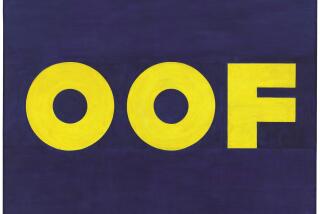ART REVIEW : KOKOSCHKA: THE FORENOON OF A FAUN
- Share via
While a widely heralded retrospective in London, Zurich and New York marks the centennial of Oskar Kokoschka’s birth, the County Museum of Art has lit a few bright candles for the Austrian Expressionist.
For “A Kokoschka Centenary: His Early Graphics” (through Aug. 31), curator Victor Carlson has made a telling selection of prints, books, post cards, drawings and one tapestry that illuminate the artist’s development. All the pieces are drawn from the vast store of Expressionist materials that Robert Gore Rifkind gave to the museum or from his private holding.
The visual centerpiece of the show is the single tapestry, a chain-stitched image of an innocent, nude young couple in a pastoral setting. This 1976 re-creation of a 1908 book illustration is a reminder that the Kokoschka we know as a painter of intensely emotional visions and anguished disillusionment was once akin to wood sprites, milkmaids and deer grazing in idyllic gardens.
Before his paintings churned with frazzled strokes of pigment, his early prints sparkled with the crisp shapes and solid colors of sophisticated folk art. Idealizing rural life, he painted such things as hunters and hounds, fables and angels. This side of Kokoschka is beautifully represented by a batch of post cards made from 1906 to 1908 while he was associated with the Vienna Workshop, an organization that fostered the Austrian version of Art Nouveau.
But the Expressionistic strain of Kokoschka that would finally twist its way into streaks of brilliance and form his historical image soon emerged in his artwork. Visiting Berlin for the first time in 1910, he met some of the German Expressionists in Die Brucke movement and identified with their disturbing passion. His gruesome self-portrait (reproduced on color lithograph posters in 1910 and 1911) depicts a cadaverous man pointing to his chest wound and marks a dramatic change in sensibility.
The tensions of love--from adolescent longings to mature misery--and the specter of death (made terrifying real by war) became his leitmotifs. Kokoschka came to see himself as a knight-errant and plunged himself into impossible love affairs, most notably with Alma Mahler. She appears as a hard woman in “The Fettered Columbus,” a 1913 series of lithographs accompanying the artist’s poem on unattainable love.
Of the portraits that anchor both ends of the show, those of the artist are among the most compelling. We find the painter bristling with confidence in 1923 and all but bursting from an exhibition poster. By 1966 he is a shaggy old man, holding the head of a faun. His touch has loosened in this late work and his energy has dissipated, but he still has an expressive way with a lithographic crayon.
More to Read
The biggest entertainment stories
Get our big stories about Hollywood, film, television, music, arts, culture and more right in your inbox as soon as they publish.
You may occasionally receive promotional content from the Los Angeles Times.










